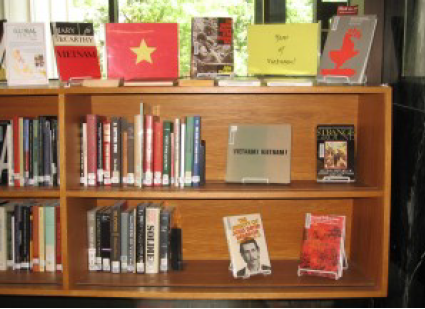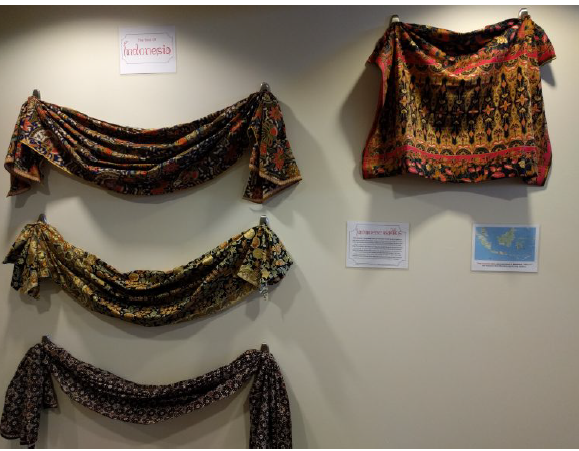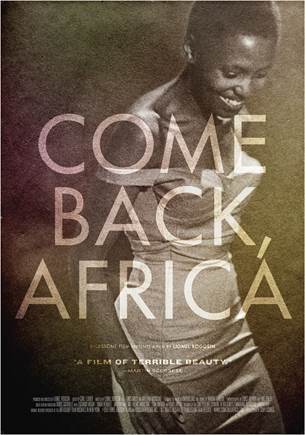Every year, the JKM Library creates displays of books and resources related to the country selected as the Global Focus country for that academic year. This year, Chatham has selected Ireland! The Year of Ireland display highlights books written by notable Irish authors or written about Ireland’s history, culture, politics, etc. The intention is to make resources available to the Chatham community so you may further educate yourselves on the country of focus selected by the university.
The display can be found on the first floor of the library in the lobby area next to the New Books display. All the materials on the Year of Ireland display are available to be checked out with your Chatham ID card. Wondering if we have a specific book that you don’t see on display? Ask a librarian! We can check our catalog for any materials you’re looking for.
Some items on display include the following. To browse more, click here!
Dublin: The Making of a Capital City by David Dickson
The Gathering by Anne Enright
The Great Hunger: Ireland 1845-1849 by Cecil Woodham Smith
Ireland’s Pirate Queen: The True Story of Grace O’Malley by Anne Chambers
Time and Tide by Edna O’Brien
Women and Politics in Contemporary Ireland: From the Margins to the Mainstream by Yvonne Galligan
Stories by Elizabeth Bowen
The Princeton History of Modern Ireland edited by Richard Bourke & Ian McBride
At Swim-Two-Birds by Flann O’Brien
The Course of Irish History edited by T.W. Moody and F.X. Martin
The Dancers Dancing by Eilís Ní Dhuibhne
Death and Nightingales: A Novel by Eugene McCabe
Ireland in Prehistory by Michael Herity and George Eogan
Commenting on blog posts requires an account.
Login is required to interact with this comment. Please and try again.
If you do not have an account, Register Now.
Every year, Chatham University chooses a Global Focus, and the 2017-2018 school year is the Year of Indonesia. In order to highlight Indonesian culture and society, the JKM Library has partnered with Dr. Greg Galford on displays that celebrate Indonesian culture and help educate our Chatham community. The first is a display of beautiful Javanese batiks purchased in Yogyakarta, Indonesia by Dr. Galford. Each of the batiks on display are incredibly beautiful, but one in particular features golden wax detailing that is truly stunning. The batik has been the source of some controversy over the years concerning the appropriation of Indonesian culture by many of its neighbors. A 2009 New York Times article detailed the struggle for cultural ownership of the batik between Indonesia and Malaysia. This was just one of many conflicts between the two nations. In September of that year, the United Nations Educational, Scientific and Cultural Organization, known as UNESCO, made the decision to add the batik to its Intangible Cultural Heritage list, meaning that its cultural meaning and significance is now protected and attributed to Indonesia (Gelling, 2009). According to UNESCO’s Intangible Cultural Heritage list, the batik is deeply rooted in Indonesian culture and plays a big part in the lives of Indonesians. Different intricate patterns are worn for everyday activities, special events, marriages, pregnancy, and other life events. Batiks feature at the birth of a child and the death of an elder. They are even incorporated into entertainment, such as puppet shows. The incredible designs drawn by craftsmen are indicative of the wide range of cultural influences Indonesia has been exposed to over the centuries. You will see elements of “Arabic calligraphy, European bouquets and Chinese phoenixes to Japanese cherry blossoms and Indian or Persian peacocks.” (Indonesian Batik, 2017) The process includes drawing beautiful designs on fabrics in hot wax which then helps to control which part of the fabric accepts the dyes and colors. This process is repeated on the same piece of fabric until the desired design is achieved (Indonesian Batik, 2017). The results are breath-taking. You can see video examples and up-close images of this process on UNESCO’s Intangible Cultural Heritage website. In another article by the New York Times that discussed the attempts to revive the batik tradition in the 1990s, batik historian T.T. Soerjanto explains how the tradition dates back 2,000 years and was first mentioned in the 15th century in the court records of Pakubuwono V, the King of Solo (Rabin, 1990). Take a look at the detailed fabric scans below of some of the batiks we have on display. Come in person to see our gilded batik in all its glory. You can find our batik display on the first floor of the library hanging on the wall partition near the elevator. Feel free to get up close and even touch the fabric, but please proceed with care. The second display is a collection of 18 books on Indonesia, provided by Dr. Galford. These books, which are both fiction and non-fiction, range in topic from history to civil engineering and infrastructure. While you are more than welcome to enjoy these books in the library, please do not remove them from the building. Below is a full list of titles in case you are interested in finding a copy for yourself! Under Construction: The Politics of Urban Space and Housing During the Decolonization of Indonesia by Freek Colombijn Island of Bali by Miguel Covarrubias Planet of Slums by Mike Davis The Traditional Architecture of Indonesia by Barry Dawson and John Gillow Balinese Dance, Drama & Music: A Guide to the Performing Arts of Bali by Wayan Dibia and Rucina Ballinger with illustration by Barbara Anello The Indonesia Reader: History, Culture by Tineke Hellwig and Eric Tagliacozzo The Year of Living Dangerously by Christopher J. Koch Behind the Postcolonial: Architecture, Urban Space and Political Cultures in Indonesia by Abidin Kusno The Appearance of Memory: Mnemonic Practices of Architecture and Urban Form in Indonesia by Abidin Kusno The Past in the Present: Architecture in Indonesia by Peter Nas Indonesia, Etc.: Exploring the Improbable Nation by Elizabeth Pisani Creative Batik by Rosi Robinson A Nation in Waiting: Indonesia’s Search for Stability by Adam Schwartz Indonesia: Peoples and Histories by Jean Gelman Taylor Indonesia: A Lonely Planet Travel Survival Kit by Justine Vaisutis Malay Archipelago by Alfred Russel Wallace The Living House: An Anthropology of Architecture in South-East Asia by Roxana Waterson Krakatoa: The day the world exploded by Simon Winchester We hope you enjoy Chatham’s Year of Indonesia! Take a moment to view our displays the next time you find yourself on the first floor of the JKM Library. References Indonesian Batik. (2017). Retrieved from https://ich.unesco.org/en/RL/indonesian-batik-00170 Gelling, P. (2009, September 14). Score One for Indonesia in the War Over Batik. The New York Times. Retrieved from http://www.nytimes.com/2009/09/15/world/asia/15iht-batik.html?mcubz=0 Rabin, R.C. (1990, February 18). The Intricate Patterning of Batik. The New York Times. Retrieved from http://www.nytimes.com/1990/02/18/travel/the-intricatepatterning-of-batik.html?pagewanted=all&mcubz=0
Commenting on blog posts requires an account.
Login is required to interact with this comment. Please and try again.
If you do not have an account, Register Now.
Commenting on blog posts requires an account.
Login is required to interact with this comment. Please and try again.
If you do not have an account, Register Now.
 August 2011
August 2011
Each year Chatham University chooses a country or region of the
world to explore during the academic year for Global Focus Year of…. This year the area of choice is Southeast
Asia: Vietnam. Vietnam is a rich and complex country with a long history of trade, colonialism, conflict, war,
and resistance.
As Americans we often first relate to Vietnam through the lens of the Vietnam War. The images and reporting on
the war in Vietnam are some of the most powerful in history. The counter movements in the United States
protesting the war are also an integral part of the history. The atrocities of the war and the uprising of Vietnamese
peasants inspired many Americans to stage protests, refuse the draft, and join international organizations.
Vietnam’s fight for independence has been a many centuries’ long struggle. In 111 BCE, the Chinese Han
Dynasty consolidated Nanyue, the ancient kingdom, into their empire. In the 10th century Vietnam regained
independence but civil fighting remained. In the 19th century France colonized much of the Asian peninsula,
including Vietnam, and imposed Western culture and religion on the countries. During this time the famous
Marxist Ho Chi Mihn called for independence, leading to the Viet Mihn and the First Indochine War. In 1954,
Vietnam was split in two, with the Communist faction moving to the North, and Ngo Dinh Diem named Prime
Minster of the South. The split was intended to quell fighting pending elections; these elections never happened,
setting in motion fear of a Communist takeover and the American intervention in the country.
The Vietnam War was in many ways a major shock to America. The use of guerrilla war tactics by the rebels,
unilateral political strategies, the use of chemical warfare that decimated people, land, and livestock, and
coverage by journalists was like nothing seen before. The counter-war movement led to violent and peaceful
protests. American soldiers took a double blow suffering the images of war and a cold reception at home. In
1976, Saigon fell.
The aftermath of the war left the country in ruin, but the Vietnamese people remained strong, many seeking
asylum in the country that hurt them. Today Vietnamese culture is rich in America and Southeast Asia a strong
player in foreign trade and travel. Vietnam is a country rich in folklore, martial art tradition, art, architecture,
and of course, food. The books on display are just some of many at the library, browse the catalog or ask a
librarian for more.
~Display and blog post by Donna Guerin, Reference Associate





It’s the year of Morocco! The global focus of the 2019-2020 academic year here at Chatham has turned its eye to this multifaceted North African country. Morocco is located in an advantageous region of the world for trade and travel, which led to a fascinating blending of cultures, customs, goods, and people. The Year of Morocco first floor book display The region of modern day Morocco was originally inhabited by Berber tribes and were under both Phoenician and then Carthaginian rule, acting as a critical resource in trade activity with the Iberian Peninsula. When Roman rule expanded and then collapsed, control of Morocco went back to the Berbers. Arab populations invaded in AD 684, adding yet another cultural element to the region. Over the centuries, Morocco found itself in a unique position in terms of early globalization. As empires blossomed and crumbled, trade expanded and new religious and scientific thought was shared. Morocco’s physical location placed it in the middle of much of this change and movement. Leadership and rule of the region changed as influence in Europe and the Middle East shifted. By the late 19th century, larger Imperialist powers in Europe were arguing over control of Morocco, and it eventually was taken by France and Spain. Morocco eventually gained its independence in 1956 after seeing much strategic action during WWII. Over the next few decades, shifting boundaries continued as previously colonized regions were returned and new boundaries were drawn all over the world, including Morocco. Political unrest also continued, and the country’s governmental structure has gone through changes as recently as the 1990s. Year of Morocco first floor book display Today, Morocco is an Islamic state (Sunni) with a hereditary constitutional monarchy with a two-chamber legislature. While the King retains veto power, there is a selected Prime Minster who runs the government. Modern Morocco has made strides in social reform, granting women increased rights and freedom, working toward decreasing unemployment, and strengthening their global relationships especially with Europe. To learn more general knowledge about Morocco, visiting our Global Focus display on the first floor of the JKM Library and check out any number of the follow fiction and non-fiction titles. You can also visit Credo Reference and read the entry for ‘Morocco’. Special thank you to Luke Peterson, the Faculty Coordinator for the Global Focus this year, for suggesting some of these amazing titles.
A History of Modern Morocco by Susan Gilson Miller
Amazir by Tom Gamble
Beyond the Veil by Fatima Mernissi
Globalizing Morocco by David Stenner
Secret Son by Laila Lalami
Travels in Asia and Africa, 1325-1354 by Ibn Batuta
This Blinding Absence of Light by Tahar Ben Jelloun
Up Above the World by Paul Bowles
Women and Property in Morocco by Vanessa Maher
Year of the Elephant by Laylá Abū Zayd
And many many more!
Commenting on blog posts requires an account.
Login is required to interact with this comment. Please and try again.
If you do not have an account, Register Now.